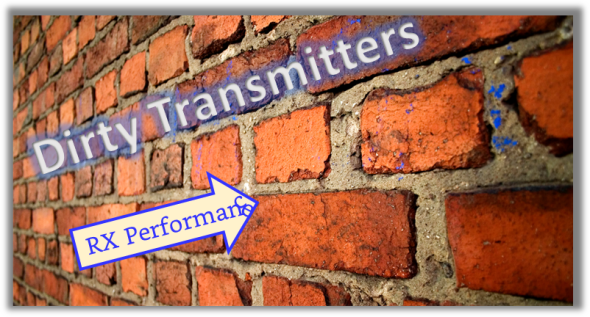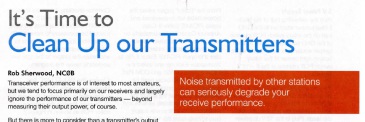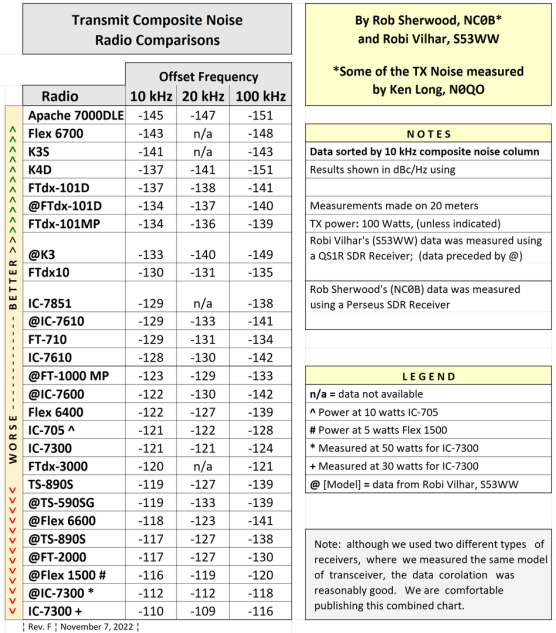Transmitter Noise / Dirty Transmitters
Receiver Performance has hit a BRICK WALL !
For the past 15 years, Ham Radio's Mega-Focus on Receiver Dynamic Range (DR3) has resulted in the community ignoring other factors that are just as important to receiver performance.
Even though our receivers have made a quantum leap in performance in important parameters such as DR3, RMDR, etc., On-The-Air Reception has gotten worse.
Unless used at a multi-transmitter site, today's typical user won't detect a difference in the receiver performance between a radio with 90 dB DR3 and a radio with 110 dB DR3. That's because Receiver Performance is not the limiting factor.
Thus, continuing to focus on improving
receiver performance is Majoring In Minors!
The fundamental performance problem is no longer the receiver;
it is the transmitters - and especially Solid State Linear Amplifiers.
Note: See Rob Sherwood's comments on this at the bottom of this page.
THE #2 PROBLEM: DIRTY TRANSMITTERS
THE #1 PROBLEM:
Most hams don't even understand what a dirty transmitter is.
For most hams, transmitter purity is judged only by IMD-3. Intermodulation Distortion.
This is of course important and is a major contributing factor to dirty Solid State Amplifiers, but it is only part of the story for the transmitter.
For the past 8 years, a few brave hams in several countries have been calling attention to this problem, but the message has mostly fallen on deaf ears.
EXAMPLES:
- (2014) SM5BSZ: . . . . . . . Band Pollution from Amateur Transmitters
- (2014) K9YC: . . . . . . . . . A Comparison of ARRL Lab Data For Selected Transceivers
- (2019) NC0B:* . . . . . . . . It's Time to Clean Up our Transmitters
- (2021) S53WW: . . . . . . . TX noise performance of modern HF transceivers
- (2021) NC0B/S53WW: . . Transmit Composit Noise Rig Comparisons
(More info on each of these below.)
*Quote from Rob Sherwood, NC0B:
"Dirty" output is a serious problem, and it is getting worse.
Three important factors can cause your transmit signal to become unacceptably dirty:
- odd-order intermodulation (splatter),
- CW keying sidebands (key clicks),
- and broadband transmitted noise.
When The ARRL published this article in QST, many hams sent comments to Rob.
Unfortunately, not one transceiver manufactured commented on the article!
HOPEFULLY this web page will awaken the ham radio community
to our Dirty TX problem and get the ball rolling towards fixing it!
The Solution: if we all turn our focus on transmitter purity and begin making our purchasing decision on this criteria, the transceiver OEM's will have no choice but to clean up their act!
WHERE TO BEGIN: IMO, the quickest way to understand the problem is to read Rob Sherwood's article published in the Nov. 2019 issue of QST Magazine. Unfortunately I do not have permission to publish a copy of that article on my web.
WHERE TO CONTINUE: BELOW
I will post downloads to the other papers, in chronological order.
Lief Asbrink, SM5BSZ
Lief was one of the first to publish papers raising awareness of this growing problem, dating back to 2005. His paper in 2014 focuses on Sideband Noise, but also references these first two papers.
NOTE: The radio listed in the second line of the Table is a Ten-Tec "Eagle" "TT-599AT", (not TS-599AT); it is a typo in his paper.
DOWNLOAD HERE:
And excellent article telling us about one of the TX Noise Problems with many of today's modern transceivers. SDR fanatics, TAKE NOTE!
Transmitter Noise Article dubus313.pdf
PDF-Dokument [553.2 KB]
Jim Brown, K9YC
The ARRL has measured transmitter noise but not done much to publicize it. Jim Brown, K9YC has recapped some of it, adding his own comments. In addition, he has included a page by Wayne Burdick, N6KR, the chief technical guru of Elecraft. Wayne explains what the typical cause of the problem is.
Note: Keep in mind that Jim wrote this paper in 2014. His comment about Yaesu transceivers were correct then . . . but Yaesu's two newest transceivers are of the cleanest currently on the market. PERHAPS Yaesu was listening!
DOWNLOAD HERE:
This document compares TX phase noise, as measured by the ARRL lab. It is commented on by Jim Brown, K9YC. The last page includes an explanation of what's wrong with many of today's radios, by Wayne Burdick, N6KR (of Elecraft)
TXNoise.pdf
PDF-Dokument [1.1 MB]
Rob Sherwood, NC0B
Robi Vilhar, S53WW
Robi and several interested hams from TK0C conducted a transmitter noise comparison test on several of the latest HF transceivers. Robi has summarized the results in a PDF.
Robi tested 3 different transmitter characteristics:
- TX composite noise
- Key Clicks
- SSB splatter using a pink noise generator
DOWNLOAD HERE:
! TX noise performance of modern HF tran[...]
PDF-Dokument [1.9 MB]
Possible Updates: http://lea.hamradio.si/~s53ww/TX%20noise/TX_noise.html
Rob Sherwood, NC0B, and Robi Vilhar, S53WW
Rob has measured several of the latest HF transceivers for transmit purity. In this paper, his results are merged with those of Robi, forming a comprehensive list of transceivers currently (2022) available on the market.
DOWNLOAD HERE:
This comprehensive list includes measured data from NC0B and S53WW. Updated 15-OCT-2022
TX Noise Chart Rev-E.pdf
PDF-Dokument [117.7 KB]
COMMENTS:
by DJ0IP: I find it curious that the IC-7300 generates ~10dB less composite noise at 100 Watts than it does at lower power levels.
by Rob Sherwood, NC0B: (source: excerpt from the QST article mentioned above)
Today, the receive performance of top-of-the-line transceivers is outstanding. A close-in 2 kHZ dynamic range of over 95 dB is common and some boast dynamic range figures of 110 dB. RMDR values of 105 to 125 dB are no longer unusual.
But this superb reception performance can be effectively crippled by a nearby signal that is dumping interference into the receiver's passband. This interference may be composite noise, key clicks, or odd-order intermodulation splatter. Regardless of the type, the receiver performance you hoped for and likely paid a substantial amount of money to enjoy is being shortchanged.
Rob Sherwood, NC0B (again): Driving a 630m Transverter with the IC-7300
The Monitor Sensors 630m transverter only requires 5 watts input on 160 meters to output 50 watts on the 475 kHz band. The composite noise (dominated by AM noise) of the 7300 is awful at some offsets at 30 watts, let alone 5 watts. For three reasons I insert at Bird 75-watt 10-dB attenuator between the output of the 7300 and the input to the transverter. This allows the 7300 to operate at 50 watts where it has a cleaner signal than at 5 watts.




























